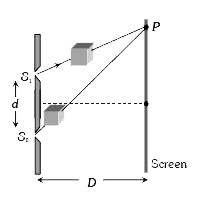In a double-slit experiment, fringes are produced using light of wavelength 4800A∘. One slit is covered by a thin plate of glass of refractive index 1.4 and the other slit by another plate of glass of double thickness and of refractive index 1.7. On doing so, the central bright fringe shifts to a position originally occupied by the fifth bright fringe from the centre. find the thickness of the glass plates.
8μm
6μm
4μm
10μm
The correct Answer is:A
Shift (Δx)=βλ(μ−1)t
Δx1=βλ(μ1−1)t
Δx2=βλ(μ2−1)t
Net shift
Δx=Δx2−Δx1=βλ(μ2−μ1)t
Given, Δx=5β=βλ[(μ2−μ1)t]
t=5λμ2−μ1=5×4800×10−101.7−1.4=8×10−6=8μm

Topper's Solved these Questions
- BOOK - ERRORLESSCHAPTER - WAVE OPTICS AND ELECTROMAGNETIC THEORYEXERCISE - NCERT BASED QUESTIONS (Diffraction of Light)20videos
WAVE OPTICS AND ELECTROMAGNETIC THEORY
- BOOK - ERRORLESSCHAPTER - WAVE OPTICS AND ELECTROMAGNETIC THEORYEXERCISE - NCERT BASED QUESTIONS (Polarization of Light)17videos
WAVE OPTICS AND ELECTROMAGNETIC THEORY
- BOOK - ERRORLESSCHAPTER - WAVE OPTICS AND ELECTROMAGNETIC THEORYEXERCISE - ASSERTION & REASON27videos
WAVE OPTICS AND ELECTROMAGNETIC THEORY
- BOOK - ERRORLESSCHAPTER - RAY OPTICSEXERCISE - Assertion & Reason30videos
RAY OPTICS
Similar Questions
A thin glass plate of refractive index 1.5 is introduced in the path of one of the interfering beam. As a result, the central bright fringe moves to a position previously occupied by the fifth bright fringe. If the wavelength of beam is 6.2×10−5cm, calculate the thickness of glass plate.
View SolutionA thin sheet of glass (μ=1.520) is introduced normally in the path of one of the two interfering waves. The central bright fringe is observed to shift to position originally occupied by the fifth bright fringe. If λ=5890Å. Find the thickness of the glass sheet.
View Solution
Knowledge Check
- Question 1 - Select One
In double slit experiment fringes are obtained using light of wavelength 4800Å One slit is covered with a thin glass film of refractive index. 1.4 and another slit is covered by a film of same thickness but refractive index 1.7. By doing so, the central fringe is shifted to fifth bright fringe in the original pattern. The thickness of glass film is
A2×10−3mmB4×10−3mmC6×10−3mmD8×10−3mm - Question 2 - Select One
In a young's double slit experiment, one of the slits is covered by a glass sheet of thickness 2.5×10−5m. Due to this, the position of the central bright fringe is shifted to position originally occupied by the 30th bright fringe. If λ=5000 Å, then the refractive index of glass is
A1.45B1.5C1.6D1.65 - Question 3 - Select One
A thin sheet of glass (refractive index 1.5) of thickness 6 microns, introduced in the path of one of the interfering beams in a double-slit experiment shift the central fringe to a position earlier occupied by the fifth bright fringe. The wavelength of light used is
A3000ÅB6000ÅC4500ÅD7000Å
Fringes are produced with monochromatic light of wave-length 5.45×10−5 cm. A thin glass plate of refractive index 1.5 is then placed normally in the path of one of the interference beams and the central bright band of the fringe system is found to move into the position previously occupied by the third bright band from the system. Find the thickness of the glass plate.
View SolutionIn YDSE, the sources is red ligth of wavelength 7×10−7m. When a thin glass plate of refractive index 1.5 is put in the path of one of the interfering beams, the central bright fringe shifts by 10−3 m to the position previously occupied by the 5th bright fringe.
What is the thickness of the plate?View SolutionIn Young's double slit experiment a mica plate of refractive index μ is introduced in the path of light coming from one of the slit . If the central bright frige gets shifted to the point originally occupied by the fourth bright fringe, then the thickness of the mica plate will be ( symbols have their usual meaning )
View SolutionIn a YDSE, fringes are produced by monochromatic light of wavelength 5450Å. A thin plate of glass of refractive index 1.5 is placed normally in the path of one of the intefering beams and the central bright band of the fringe system is found to move into the position previoysly occupied by the third band from the centre. select the correct alternatie
View SolutionFringes are produced with monochromatic light of wavelength 5500 Å. A thin glass plate of R.I. 1.5 is then placed normally in one of the paths of interfering beams and the central bright fringe is found to be shifted to the position, previously occupied by the third bright band from the centre. the thickness of the glass plate is
View Solution
